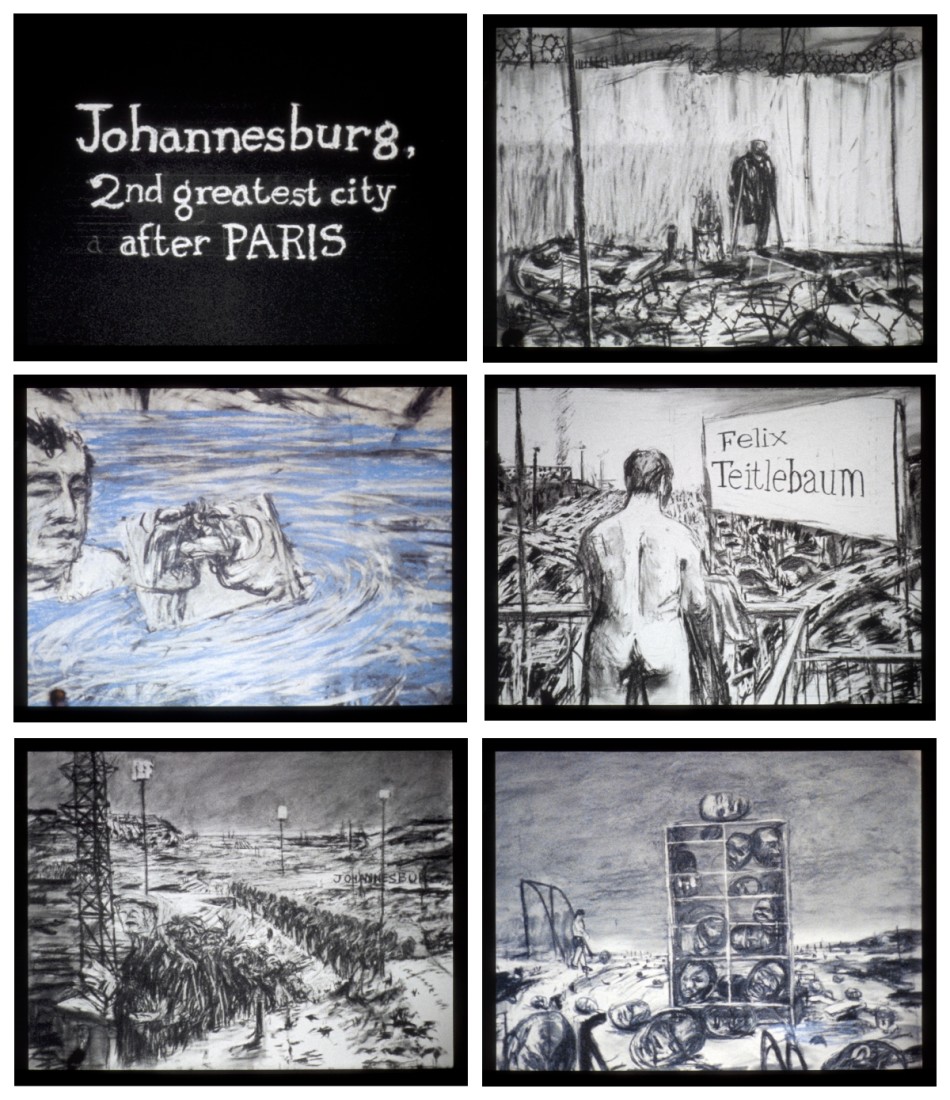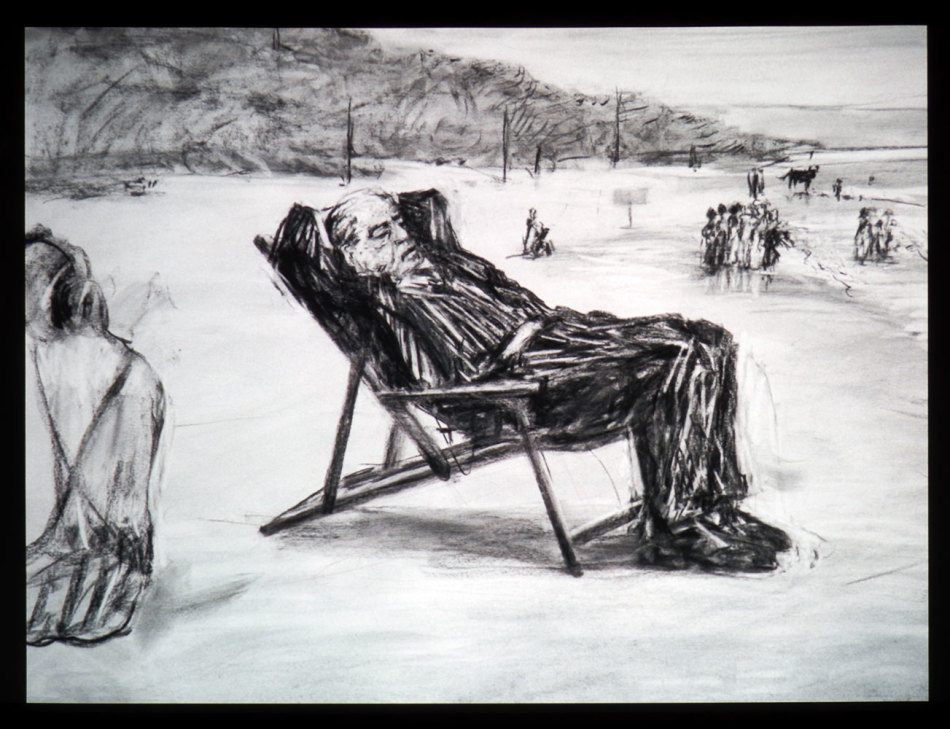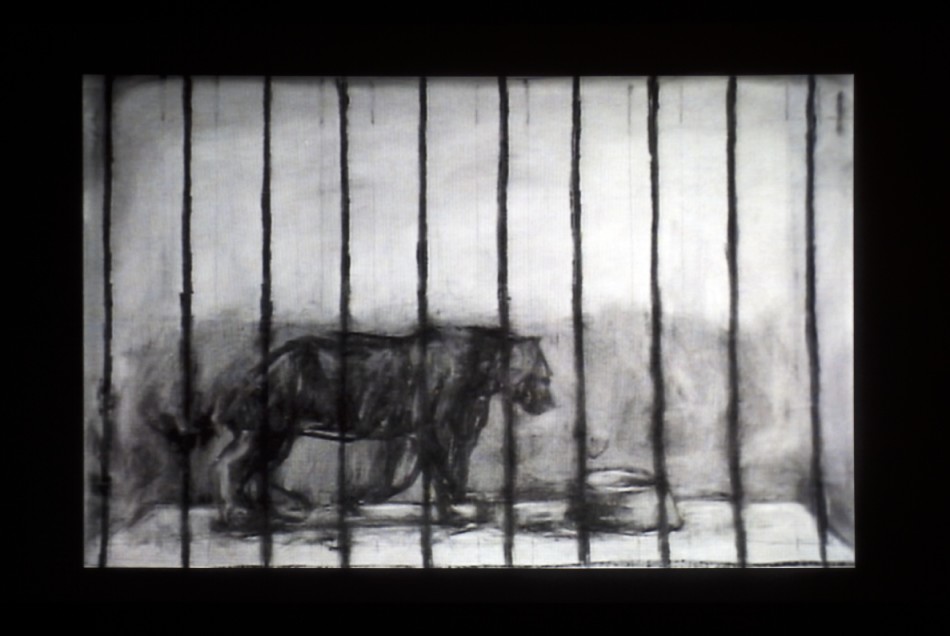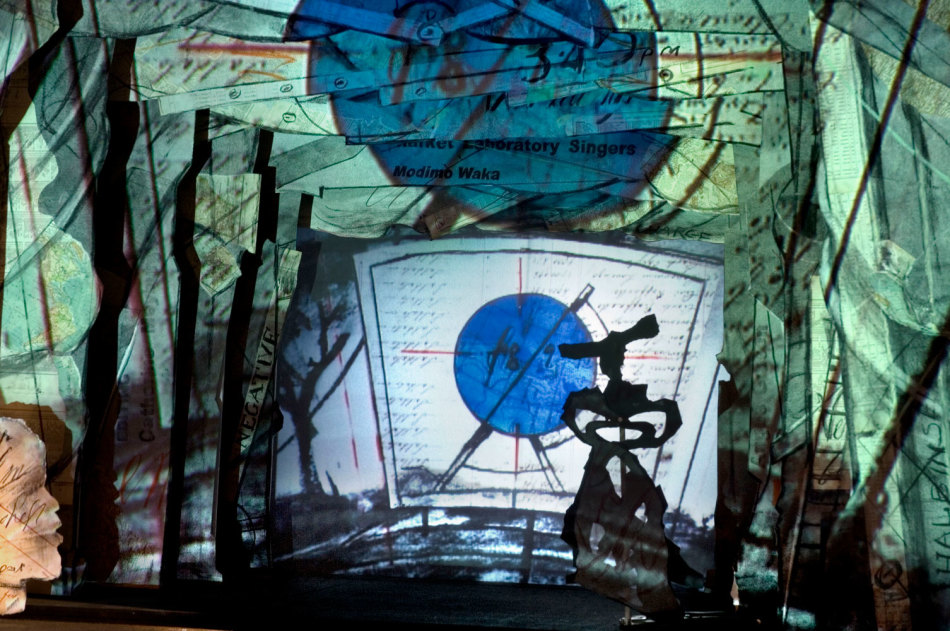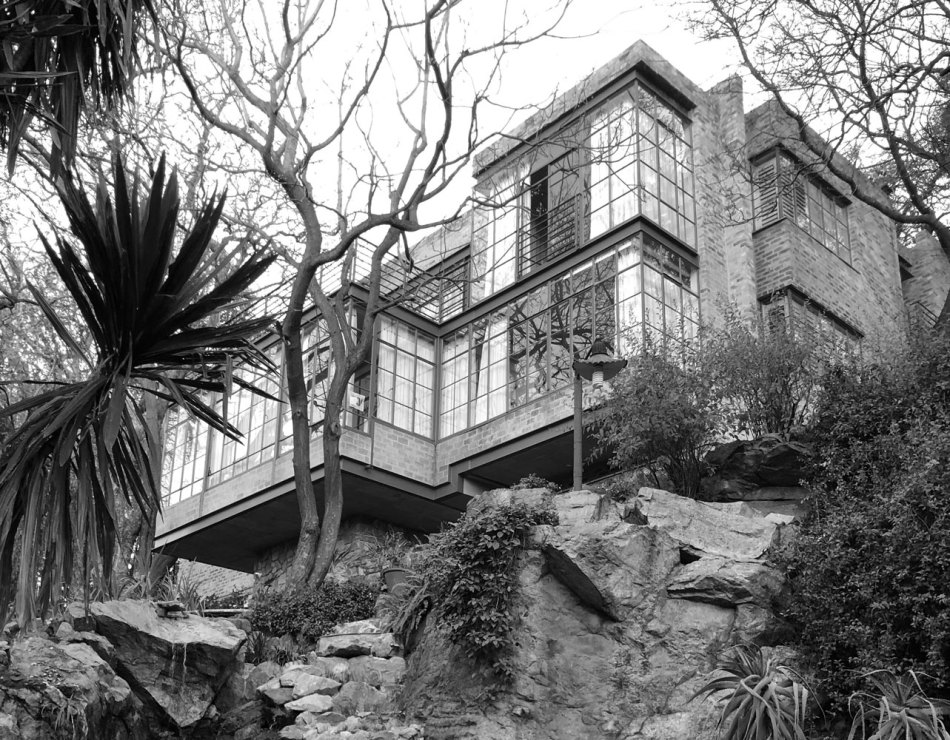William Kentridge’s life, art, and studio
William Kentridge’s life, art, and studio
Published 1 November 2022
William Kentridge’s drawings, animations and installations bear witness to the history of his native South Africa. As his art expands across the Royal Academy’s galleries, take a deep dive into his immersive hand-drawn world.
-
From the Autumn 2022 issue of RA Magazine, issued quarterly to Friends of the RA.
The automatic gate at the entrance to the Johannesburg home and studio of William Kentridge is topped with two bristling cats. Longstanding features of the property, the steel felines are a declaration of personality in a suburban enclave characterised by its barricaded anonymity. Cutely menacing, Kentridge’s self-described “electrified cats” bear little in common with, say, the famous psychedelic cats of the painter Louis Wain. If anything, their spiky design, like his 2012 etching Toby, reveal his indebtedness to a locally evolved strain of Expressionism that Kentridge encountered daily as a child. When he was six, he received the gift of a print from artist Cecil Skotnes, a family friend. It depicted a striped cat with arched back and fearsome claws in the style of German Expressionist Ernst Ludwig Kirchner. Displayed in his childhood bedroom, it lodged a primal image in his mind.
-

William Kentridge, Toby, 2010.
Sugarlift & spitbite aquatint, drypoint, and hand-painting on 6 shaped sheets of Hahnemuhle paper. 101.6 × 177.8 cm. William Kentridge Studio, Johannesburg © William Kentridge.
-
Cats are now an integral part of Kentridge’s visual lexicon, which is profuse but nonetheless quantifiable. Besides the stalking felines, his playful iconography includes scampering coffee pots, anthropomorphic projectors, antique telephones, colossal ampersands, humanoid megaphones, lost noses and lumbering humans bearing strange loads. These inventions originated from his prints and drawings, two foundational media in Kentridge’s journey as an artist since the late 1970s. Over time his bountiful output has grown to encompass archaic stop-animation films tinged with biographical resonance, charcoal-hued sculptures, grand tapestries featuring maps and silhouetted figures, installations that revive the spectacle of 18th-century mechanical theatre and vivid stage productions marked by his distinctive set designs. It is an astonishing body of work, a determined selection of which inhabits the RA’s galleries this autumn.
The undoing of apartheid and its racially skewed privileges forms the backdrop to Kentridge’s majestic and melancholy art. His RA exhibition includes five of the artist’s eleven stop-animation films. Inaugurated in 1989 with the eight-minute film Johannesburg, 2nd Greatest City After Paris, his celebrated ‘Drawings for Projection’ series episodically and impressionistically examines South Africa’s history of colonial conquest, mineral extraction, labour exploitation and political upheaval, through the lives of two fictional characters: Soho Eckstein, an aging industrialist with a proclivity for pinstripe suits (middle row, right, in the image below), and artist Felix Teitlebaum, whose indiscretions include an affair with Eckstein’s wife (middle row, left, in the image below). The films sparked fascination in Kentridge beyond South Africa in the later 1990s. Partly this was due to the opening up of the politically and culturally isolated country. However, the formal qualities of his “stone-age filmmaking” process, as Kentridge put it, also played a part.
-

William Kentridge, Johannesburg, 2nd Greatest City After Paris, 1989.
16 mm film transferred to video. 8 minutes 2 seconds. William Kentridge Studio, Johannesburg. © William Kentridge.
-
The films’ scenes of social disquiet and personal anxiety are composed with charcoal on large pieces of white paper, and are then incrementally evolved, through erasure and redrawing, for the camera. The process yields a rich palimpsest, a heaping of memory onto the page. “Erasure becomes a kind of pentimento, an element of layering as you get in painting, but it is more ghostly in drawing”, Kentridge told a curator in 2009. “Erasure also makes palpable the activity of the work.”
The changing character of the artist’s hometown, Johannesburg, is also an explicit focus of his films. The electrified perimeter of his Houghton residence is linked to a larger constellation of woes besetting the city, and indeed South Africa, including poverty, social inequality, enduring racial animus and state incompetence in addressing a collapsing civic infrastructure. Electricity blackouts are now routine across the country.
“I stay in Johannesburg because I can imagine not staying here”, said Kentridge during my visit to his studio in May. It was late at night. The artist was slumped on a chaise longue. His studio, a place of intense bustle earlier in the day, was quiet. “It would be manageable. I have the ability, the passport and the resources not to have to be here, which makes it a less urgent question. But it – my staying here – does exist as a question.”
More so than Felix Teitlebaum, who in the early films clearly resembled Kentridge, the unlikable Soho Eckstein has emerged as a vehicle for the artist to explore the real-life burdens and existential responsibilities of living in contemporary South Africa. Eckstein features prominently in Kentridge’s most recent film, City Deep (2020), which shows the rotund industrialist wandering through Johannesburg Art Gallery, a municipal museum designed in an imperial style by Edwin Lutyens RA. These scenes of culture and leisure are juxtaposed with Kentridge’s portrayal of the illicit scavenger mining that presently occurs at the shuttered gold mines linked to Johannesburg’s early beginnings and wealth.
-

William Kentridge, Tide Table, 2003.
35 mm film transferred to video. 8 minutes 50 seconds. William Kentridge Studio, Johannesburg. © William Kentridge.
-
Soho Eckstein is a beneficiary of this history. His provenance as a character is complex. Eckstein was gestated in drawings Kentridge made in the 1970s and 80s for theatre and trade union posters, as well as the Hogarth-inspired print suite Industry & Idleness (1986). “He was absolutely the industrialist taking over Johannesburg”, said Kentridge of Eckstein’s introduction in 1989. As an archetype of plutocratic avarice and white greed Eckstein has exercised the energies of many commentators. Critic Waldemar Januszczak dismissed Eckstein as an antisemitic slur in an excoriating review of the artist’s first-ever London survey in 1999. More recently, in 2018, scholar Fred Moten characterised Eckstein as embodying the brutality of South African capitalism.
While grounded in leftist archetypes of the robber baron, Kentridge’s understanding of Eckstein has grown more complex over time. The 2003 film Tide Table, for example, portrays Eckstein in his suit lazing on a beach. It is based on a family photograph of the artist’s parliamentarian grandfather, Morris Kentridge, whose 1959 political memoir, I Recall, features a political cartoon of a portly Jewish man stuffed into a suit on its cover. “You think you have control over the characters and what they do, but you don’t”, said Kentridge, whose maturing draughtsmanship has also added complexity to Eckstein’s appearance. It is worth pausing on this change, which is discernible throughout Kentridge’s work, even in his portrayal of cats. Over the years, we have often spoken about Soho Eckstein but only once about cats. Given the tenor of Kentridge’s sober examinations of entitled white life in apartheid South Africa – a concern that he has parlayed into an investigation of the role of the artist amid the struggles and violence of the previous century in Africa and Europe – it is fair to wonder what the apparently minor figure of a cat might tell us about this prolific artist and his work. Actually quite a bit. Among the great many cats he has drawn, his depictions of a graceful panther yield a potential answer. In 2001, Kentridge, a serial collaborator, initiated a new project with composer Kevin Volans, playwright Jane Taylor and the Cape Town theatre troupe Handspring Puppet Company. Confessions of Zeno, the second of their multimedia oratorios, was staged at Documenta XI in Kassel in 2002. The production included an animation of a caged panther. The image is directly linked to Kentridge’s identity as an artist, following a reset in the mid-1980s of his failed art career.
-

William Kentridge, The caged panther from 'Confessions of Zeno', 2002.
Charcoal and coloured chalk. 80 x 120cm. Acquired with funding from The New Carlsberg Foundation © William Kentridge.
-
Kentridge presented his debut solo exhibition at Johannesburg’s Market Gallery in 1979. It comprised pencil drawings and a suite of heavily inked monotypes depicting naked white figures (one resembles Felix Teitlebaum) in animated poses in minimally delineated interior spaces. The artist’s will to cover the white area of the page in black registers from the start, as does his use of quotation; “Goya’s bullfights were certainly in my mind”, Kentridge later said. Goya, Hogarth, Dürer, Beckmann: his art is heavily indebted to the Western canon. In 1979, though, his voluptuous white nudes in dark rooms were discontinuous with trends in South African art, which saw progressive white artists dismiss the figure as passé.
“It was all about the reductive, the minimal and systems”, recalled Steven Sack, an artist and long-time friend of Kentridge, invoking the prevailing dogmas that entranced the white avant-garde. The two met at university in Johannesburg in the early 1970s and were both members of the Junction Avenue Theatre Company, a workshop-method ensemble founded in 1976 and named after the street in which many of its members lived. Kentridge and Sack inhabited studios opposite each other. Sack remembers a large painting of a “very voluptuous, Rubensesque pink nude” in Kentridge’s studio, which he says the artist fought to complete but ultimately abandoned. In 1978, they collaborated on Kentridge’s first animated film, Title/Tale.
Sack also assisted Kentridge with the construction of an elaborate contraption for the children’s play Wooze Bear (1977). Their mechanical device was inspired by Norman Hunter’s storybook character Professor Branestawm and is, said Sack, a direct precursor to Kentridge’s contemporary sculptures and mechanical installations. These include Black Box/Chambre Noire from 2005, a miniature theatre housing kinetic sculptures and animation that features in Kentridge’s RA show. The spectacle of the dancing compass and articulating rhino in Black Box does little to defuse the horror of the work’s subject: the Herero and Nama genocide of 1904-08 in what is now Namibia. Kentridge’s skill as an artist emerges from his embrace of theatricality and artifice – big no-nos of 1970s art discourse – as tools to examine dark histories.
-

William Kentridge, Black Box / Chambre Noire, 2005.
Animated 35 mm film transferred to video, projected front and back onto model theatre with drawings and mechanical puppets. 22 minutes, object 360 x 200 x 139.5 cm. Louisiana Museum of Modern Art, Humlebaek, Denmark. Acquired with funding from The New Carlsberg Foundation. © William Kentridge.
-
In many respects, Kentridge’s first exhibition represented a detour from his activities in theatre and incipient film experiments. He briefly stopped making art and closed his studio. “It was a critical time of assessing what it is I do well, or at least how a few of the different things I do well could find a place”, Kentridge told the curator Michael Auping in 2009. In 1981, he spent a year at a Parisian theatre school. Three years later, recently wed to Anne Stanwix, an Australian-born doctor, Kentridge read Rainer Maria Rilke’s poem The Panther (1902) for the first time. The poem about a weary panther circling its enclosure was revelatory. Kentridge would only fully rationalise why much later, after a fateful renegotiation of his professional status.
Here the world owes a debt of gratitude to Reinhold Cassirer, a scion of the Berlin family of art dealers, who pressed Kentridge to return to the studio. “He was either very determined or very deaf”, said Kentridge. “I told him, ‘I am not drawing anymore, I am working in the film industry.’ He responded, ‘Yes, yes, but when can we have an exhibition?’ It was important that there was someone who hadn’t heard that I had stopped, or didn’t believe that I had stopped.” Kentridge tentatively resumed drawing.
In 2012, during the fifth of his six Charles Eliot Norton Lectures – an award bestowed by Harvard University on cultural luminaries, among them T. S. Eliot and Jorge Luis Borges – Kentridge likened the experience of being a young artist back in the studio to Rilke’s caged panther. He experienced bouts of creative energy followed by moments of lassitude. His pacing, a constant of his studio method, even today, served up intractable questions. ‘What is to be done? What are the images to be made?’
Rilke’s poem presented an answer. Kentridge learnt that the poet had worked as a secretary for the sculptor Auguste Rodin. Like Kentridge, Rilke had been stuck over what to compose. One day Rilke’s master packed him off to the zoo with the injunction not to return until he had written about something he had seen. The Panther was “one of the great poems of the last century, and it started life as a homework exercise”, Kentridge told his Harvard audience. He immediately added: “But the relief in the poem is the relief of recognising yourself.”
What had seemed a fault, a mistake, a moral weakness, his inaction, his dithering, his falling asleep on the job, was in fact, Kentridge realised, how things are in the world: energy and possibility, the drive to do and make, are met with pacing, deflation, nothing, a blank page. Kentridge often narrates his biography by cataloguing his failures. He was a failed artist, he will tell you, who turned to acting and filmmaking, which he wasn’t much good at, so he returned to art, albeit furnished with the insights of his youthful ineptitude. “I could certainly write my biography in terms of being saved by my failures”, Kentridge told me in 2005. “I work from not knowing what I am doing, from doubt, from indecision, from failure.”
-

A workshop takes place in Kentridge’s studio to develop a new film, 2021
William Kentridge Studio, Johannesburg © William Kentridge
-
Kentridge is also an urbane conversationalist whose modesty can be confused for flippancy. During lunch on the veranda of his home in 2014, responding to my question about his unwritten biography, Kentridge said: “The truth is that there is not much of a biography to write. It is growing up here and staying. There are no great moments of transformation. There is no six months in Tahiti.” What about his time studying theatre in Paris in 1981? “And the six months in New York”, he volleyed my question, and then quickly despatched of himself – and my question – in the third person. “But then he went into the studio and worked, and then he went home, which meant walking across the garden.”
Kentridge’s first experience of the leafy garden that we overlooked during that lunch goes back to 1963. He was eight when his parents, lawyers Sydney and Felicia Kentridge, moved into their new home in Johannesburg’s privileged northern suburbs. The young family were progeny of driven and educated Lithuanian Jews. Irene Geffen, Felicia’s grandmother, was South Africa’s first female advocate. Felicia also studied law and co-founded the Legal Resources Centre, a public interest law firm, as a bulwark against human rights abuses. Sydney too was a prominent anti-apartheid lawyer who was knighted in 1999.
The respectability implied by the Kentridge family name is deeply coded into the tidy Arts and Crafts-style home with terraced garden that is still occupied by the artist. In 1978 David Goldblatt photographed the Kentridge family garden, showing a lone swing on a mown lawn with a backdrop of maturing trees. Trees in Johannesburg, a water shy city without a major river, are signs of privilege.
“To not need the tree for either wood or fire is a luxury”, wrote the artist in 2018, in a catalogue for a show in Sydney. Trees have long fascinated Kentridge. When he was nine, his father planted two white stinkwoods in the garden. “All my childhood I waited for the trees to grow, to be strong enough to hold a hammock”, he wrote in 2018. “They refused.” By the time Kentridge moved back into his family home in the late 1990s when his parents retired to England, the trees had matured. He nurtured their magnificence.
-

William Kentridge, Not Everywhere But Anywhere, 2021.
Indian ink on hemp and sisal Phumani paper, mounted onto raw cotton. 331 x 308 cm. Marian Goodman Gallery. © William Kentridge.
-
“And then one of them was struck by lightning and died. The shock, not just the hole in the shade canopy, the gap in the garden, but rather the shaking of the belief that a tree is a gift for future generations or – if not for future generations – then at least for other people… its lifespan should be so much longer. How could the tree die before me? No. If the tree could die, how vulnerable are we or am I?” A gallery at the RA is dedicated to Kentridge’s recent series of ink drawings of trees, made on a large scale that monumentalises these arboreal subjects as fragile icons of solidity, flux and not knowing (for example, in Not Everywhere But Anywhere, from 2021). The trees are overlaid with text, an allusion to the Sibyl of Cumae; written on oak leaves and left at the mouth of her cave, the Roman priestess’s prophecies were scattered by the wind, confusing the fates of those who asked questions of the oracle.
The two-floor home Kentridge grew up in remains largely unchanged. The wood panelling in the entrance hall is extensively decorated with art. There are prints by Albrecht Dürer and John Muafangejo, as well as photographs by André Kertész, Jo Ractliffe and Aleksander Rodchenko. They chart a history of travel, appreciation, friendship and influence. The guest bathroom is decorated with maps and old family photos, including one from 1893 of Woolf Kantrovich, the artist’s great-grandfather, who had been a cantor in Sunderland before settling in South Africa, where he anglicised the family surname to Kentridge.
In 2001, Kentridge built a voluminous studio next to his home. Shaded by a large South American ombu tree, it has an extensive central working area flanked by a workshop, video-editing suite, office and guest bedroom (where Kentridge retreats in the afternoons for biokinetics). Once a quiet refuge that doubled as a storeroom, over the years the studio has become increasingly congested. During my May visit technicians and assistants laboured in every available space.
-

The exterior of Kentridge’s first studio in Johannesburg, completed in 2001 next to his home
Photo: Damon Garstang
-
“Today is a bit insane, because it is just before I travel”, remarked Kentridge. He was due in New York to receive an honorary doctorate from Columbia University, along with Hillary Clinton and Patti Smith. In the space of that compressed day he signed new print editions, remarked on castings for new sculpture editions, fielded calls from his various dealers, marvelled with a curator at architectural models for an exhibition in Johannesburg, discussed edits on a new live-action film based around Dmitri Shostakovich’s 10th Symphony with three technicians, and fielded questions in our interview.
Kentridge is neither reserved nor secretive in his studio. Openness and inclusion typify his affable manner. In March, he filmed a brass band performing in front of a large drawing of a flower display in his space. In 2010, prompted by his growing success, Kentridge acquired a second studio in central Johannesburg for larger sculptural work and performance workshops. Work on 2018’s The Head & the Load, a theatrical spectacle combining music, dance, spoken word, film projections, mechanised sculptures and shadow play that premièred at Tate Modern, was supervised in this downtown space.
-

William Kentridge, The Head & The Load.
Photo: Stephanie Berger.
-
In the year before this much-lauded production, Kentridge established the Centre for the Less Good Idea (the name draws on a Tswana proverb, ‘If the good doctor can’t cure you, find the less good doctor’). The centre, based at his second studio, promotes collective thinking and collaborative methods that challenge grand certainties. “Every large idea has let us down and is accompanied by invading armies”, Kentridge told a New York audience in 2018 of his centre’s guiding philosophy. “Our only hope is to try to find ideas at the margins, small provisional ways of working, and in this way make our way through the morass of the contemporary world.”
For Kentridge the studio is the key place for these small discoveries. More than a place of work, it is a safe space for failure, as well as a site where thought is materialised and tested. “The studio is such a sanctified space for many artists, because it is a space of trial and error, and not everybody allows you to see their errors, but William does”, said Koyo Kouoh, the Cameroonian-born director and chief curator of Zeitz Museum of Contemporary Art Africa in Cape Town, which in 2019 hosted an extensive survey of his drawing practice. “You see another side to William there, a very different side”, agreed Adrian Locke, the RA’s chief curator, who has twice visited Kentridge in Johannesburg. “You get to appreciate how he thinks and works through things. And then there is the pure delight of having lunch around a table in the garden, where everyone chats about everyday life.” Lunches are a hallmark of the artist’s hospitality. Open to everyone at the studio, which in May numbered more than a dozen people, it is easy to be beguiled by the carefree table talk. For artist Gerhard Marx, a long-time collaborator with Kentridge, these lunches were an education in his egalitarian ethos and bonhomie. In the lead up to his directorial supervision of Mozart’s The Magic Flute, for La Monnaie in Brussels in 2005, Kentridge asked Marx for drafting assistance in his studio for a projection he planned for the stage. “It was amazing and frightening. On my first day, he asked me to draw cumulous clouds for the background on a 12-metre roll of paper for the camera to pan across.” The apprenticeship included lessons beyond drafting and collaboration as method. Kentridge is a prolific worker. “You begin to understand the value of those studio lunches, because the rest of the time you really work.”
The labour of drawing sits at the centre of everything Kentridge does. “For me drawing is the heart of the activity, even if the drawing is done with an actor rather than a stick of charcoal,” he explained during a walkthrough of his 2019 Zeitz Museum show. “It is finding a medium in which to think, rather than technically carrying out the illustration of an idea you have had.” The Head & the Load was an elaboration of his method of drawing in performance. Drawing also forms “the spine of the RA show”, said Locke. “William is an absolutely brilliant draughtsman, working in charcoal and Indian ink in this effortless, expressive manner. It’s the development of his drawing that narrates his story as an artist.”
-

William Kentridge, The Conservationist’s Ball, triptych, 1985.
Charcoal, pastel and gouache on paper. 198.5 x 97.5 cm; 198.5 x 138.5 cm; 198.5 x 97.5 cm. Rembrandt van Rijn Art Foundation collection. Rupert Museum, Stellenbosch, South Africa. © William Kentridge.
-
Kentridge began drawing at an early age and started formal art lessons at age eight. During his adolescence he studied under artist Bill Ainslie, whose rigorous academic programme and expressionist enthusiasms exerted a considerable influence. The RA exhibition begins with a room of drawings made when Kentridge was in his early thirties. They include The Conservationists’ Ball from 1985, a surrealistic triptych that typifies his early high-expressionist phase. The three panels describe the genteel white citizenry of a Europeanised city lazing at home, frolicking in a café and stuck in traffic. Wild animals (cheetah, rhino, hyena) ambiguously inhabit the panels, as well as animal carcases. Indictment was front and centre of Kentridge’s thinking in his early drawings.
“White guilt is much maligned”, he stated in a 1986 lecture. “Its most dominant feature is its rarity. It exists in small drops taken at infrequent intervals and its effects do not last for long.” Kentridge remains aware of, as he stated in 1986, and also draws sustenance from, the “anomaly” of his position of being “at the edge of huge social upheavals, yet also removed from them”, but not wanting to ‘work as if they did not exist”.
The excoriating tone of his drawings and writings from the mid-1980s were informed by the accusatory style of Brechtian theatre, of which Junction Avenue’s players were disciples. His drawings also extended to the concerns in Domestic Scenes (1980), a suite of etchings and aquatints describing scenes of languor, intimacy, carnality and animality. Kentridge, an admirer of Honoré Daumier, was not averse to satire. He briefly and unsuccessfully jobbed as a political cartoonist for the leftist Weekly Mail in 1985.
“He has clearly grown in confidence as he has matured”, says Locke. “What is fascinating is that his drawings remain very much rooted in Johannesburg. He understands and knows the place best, and hasn’t tired of trying to represent the city in all its myriad complications and challenges.” This extends to a drawing for the animation City Deep that shows Soho Eckstein appraising a vitrine in a wing of the Johannesburg Art Gallery. This grand civic building is currently imperilled by persistent leaks, vandalism, theft and longstanding budget issues, and faces possible closure. What are we to make of this scene showing a melancholy industrialist swaddled in pinstripes, surveying a vitrine in this building connected to empire?
-

William Kentridge, Drawing for City Deep, 2018.
Charcoal and red pencil on paper. 104.5 x 152 cm. Private collection, courtesy A4 Arts Foundation. © William Kentridge.
-
Among the many catalogues and books devoted to Kentridge, one possesses an almost Talmudic authority in the artist’s studio. It is a well-thumbed copy of curator Carolyn Christov-Bakargiev’s catalogue that accompanied Kentridge’s first major international survey, staged in Brussels in 1998. “She spent a lot of time in the studio, doing the rigorous work of putting the archive in order”, explained Kentridge. This close proximity to the artist, his studio, his lunch table and the residue of his antic beginnings provided Christov-Bakargiev with many, sometimes prescient insights.
“Writing about Kentridge from a distant cultural perspective is problematic”, she pointed out in the introduction. The reasons are many but principally involve the risk of platitudinal contextualisation of Kentridge and an avoidance of Europe’s deep complicity in the narratives figured in his work. Those responsibilities include the German army’s genocide in Namibia, examined in Black Box; the neglected contribution of black Africans to the First World War, brilliantly revealed in The Head & the Load; and Johannesburg’s origins in European resource extraction in South Africa, the enduring subtext to Kentridge’s stop-animation films. Despite her European location and identity, Christov-Bakargiev identified with the relevance of Kentridge’s ethical and artistic endeavour. “It explores a border zone where identity is hybrid, multiple and shifting, between remembering and forgetting, between belonging to a tradition of fine art and being relegated to its margins.”
-

William Kentridge, Drawing for The Head & the Load (O, the trumpets we used to blow), 2018.
Charcoal, red pencil and text on paper. 101.5 x 75 cm. Evan and Natalie Hoff © William Kentridge.
-
Kentridge’s wholesale uptake by the global north has, for me, long been marked by a notable silence. What does Africa make of him? Kenyan painter Michael Armitage RA, who in 2017 invited Kentridge to address an artists’ forum he organised outside Nairobi, told me of the great excitement the artist’s presence generated. But the most intriguing testimonial came from Zeitz Museum’s Koyo Kouoh. She first met Kentridge in the Senegalese capital of Dakar in the early 2000s, but only got to work with him in 2019.
“I have never seen an artist who is so present and dedicated to work or a curatorial process”, said Kouoh. “He is the first to arrive and the last to leave.” She agreed that his genre-hopping collaborative method linked him to her friend and mentor, the Senegalese artist and playwright Issa Samb, who in 1973 co-founded the influential collective Laboratoire Agit’Art. “The level of generosity, the sense of building and giving, of growing ideas and people, are absolutely comparable.”
Praise, Kentridge will tell you, quoting a Dadaist proverb conceived by his wife, is like the gift of wet rhino on your doorstep, and bitter critics, he has discovered, are far less authoritative when encountered in person. Also, he repeated from his chaise, hushed suburbs twinkling in the distance, talking has its limits. The social urgencies and inequalities he confronted in 1984 endure. Johannesburg, the place he calls home, is in a state. South Africa is lurching. The world too is in a strange way. “What is to be done? What are the images to be made?” The answer to these evergreen questions, he knows, will reveal themselves in the pacing of his studio, in the filling of a blank page with charcoal marks. ”It’s about making, and when the thing is made you can see what it means.” Not conclusively, but rather provisionally, for the drawings are always incomplete and certainty as elusive as the oracles left by the Sibyl on wind-scrambled leaves.
Sean O’Toole is a Cape Town-based critic and journalist. He is a contributing editor of frieze magazine.
-
-

Enjoyed this article?
Become a Friend to receive RA Magazine
As well as free entry to all of our exhibitions, Friends of the RA enjoy one of Britain’s most respected art magazines, delivered directly to your door. Why not join the club?
-

